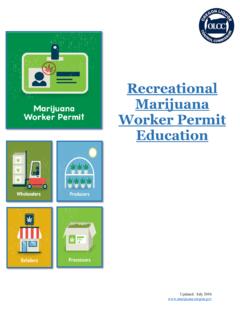Transcription of Public Speaking Handbook - Pearson
1 Public Speaking HandbookSixth EditionSteven A. BeebeTexas State UniversitySusan J. BeebeTexas State 310/5/17 11:07 PMCredits and acknowledgments borrowed from other sources and reproduced, with permission, in this textbook appear on the appropriate page of appearance or in the Credits on pages 439 2019, 2016, 2013 by Pearson Education, Inc. or its affiliates. All Rights Reserved. Printed in the United States of America. This publication is protected by copyright, and permission should be obtained from the publisher prior to any prohibited reproduction, storage in a retrieval system, or transmission in any form or by any means, electronic, mechanical, photocopying, re-cording, or otherwise. For information regarding permissions, request forms and the appropriate contacts within the Pearson Education Global Rights & Permissions department, please visit www.
2 , ALWAYS LEARNING, and Revel are exclusive trademarks in the and/or other countries owned by Pearson Education, Inc. or its otherwise indicated herein, any third-party trademarks that may appear in this work are the property of their respective owners and any references to third-party trademarks, logos or other trade dress are for demonstrative or descriptive purposes only. Such references are not intended to imply any sponsorship, endorsement, authorization, or promotion of Pearson s products by the owners of such marks, or any relationship between the owner and Pearson Education, Inc. or its affiliates, authors, licensees or of Congress Cataloging-in-Publication DataNames: Beebe, Steven A., author. | Beebe, Susan J.
3 , : Public Speaking Handbook / Steven A. Beebe, Susan J. : Sixth edition. | Boston : Pearson , [2017] | Previous edition: : LCCN 2017033201| ISBN 9780134623092 | ISBN 0134623096 Subjects: LCSH: Public Speaking . | Oral : LCC .B44 2017 | DDC dc23 LC record available at , Portfolio Management: Karon BowersContent Producer: Barbara CappuccioContent Developer: Ellen KeohanePortfolio Manager Assistant: Dea BarbieriProduct Marketer: Christopher BrownField Marketer: Kelly RossContent Producer Manager: Melissa FeimerContent Development Manager: Sharon GearyManaging Editor: Maggie BarbieriContent Developer, Learning Tools: Amy WetzelArt/Designer: Kathryn FootDigital Studio Course Producer: Amanda SmithFull-Service Project Manager: SPi GlobalCompositor: SPi GlobalPrinter/Binder: LSC Communications, Printer: Phoenix Color/HagerstownCover Designer: Lumina Datamatics, Credit: Cover illustration by Greg Betza, 10.
4 0-13-462309-6 ISBN 13: 978-0-13-462309-21 410/5/17 11:07 PMDedicated to our parents,Russell and Muriel Beebeand Herb and Jane Dyeand to our children,Mark, Amanda, and Matthew 510/5/17 11:07 610/5/17 11:07 PMviiContentsPreface xiPart 1 Introduction 1 Introduction to Public Speaking 1 What Is Public Speaking ? 2 Why Study Public Speaking ? 3 QUICK CHECK Why Study Public Speaking ? 4 The Communication Process 4 QUICK CHECK The Communication Process 8 The Rich Heritage of Public Speaking 8 QUICK CHECK The Rich Heritage of Public Speaking 10 2 Speaking with Confidence 13 Understand Your Nervousness 15 HOW TO Make Your Understanding of Anxiety Work for You 16 QUICK CHECK Understand Your Nervousness 17 How to Build Your Confidence 18 HOW TO Channel Your Energy 20 HOW TO Get and Give Support in Public - Speaking Class 22 QUICK CHECK Build Your Confidence 23 3 Presenting Your First Speech 25 Consider Your Audience 26 The Audience-Centered Speechmaking Process 28 HOW TO Pick a Speech Topic 29 HOW TO Develop and Use a Specific Purpose 30 HOW TO
5 Identify the Main Ideas in Your Speech 31 SAMPLE OUTLINE 33 SAMPLE SPEECH Cinderella by Grace Hildenbrand 37 4 Speaking Freely and Ethically 41 Speaking Freely 43 QUICK CHECK History of Free Speech in the United States 46 Speaking Ethically 47 HOW TO Incorporate an Oral Citation into Your Speech 52 QUICK CHECK The Ethical Public Speaker .. 53 Speaking Credibly 53 Part 2 Analyzing an Audience 5 Listening to Speeches 57 Overcoming Barriers to Effective Listening 60 HOW TO Prevent Listener Fatigue 61 HOW TO Minimize Outside Distractions 63 HOW TO Counteract Prejudice 63 How to Become a Better Listener 64 HOW TO Become an Active Listener 69 Improving Critical Listening and Thinking Skills 70 QUICK CHECK Critical Thinking and Listening 72 Analyzing and Evaluating Speeches 72 QUICK CHECK Giving Good Feedback 77 6 Analyzing Your Audience 81 HOW TO Become an Audience- Centered Speaker 84 Gathering Information about Your Audience 84 HOW TO Develop a Survey 710/5/17 11.
6 08 PMviii Contents Analyzing Information about Your Audience 87 QUICK CHECK Analyzing Audience Information 89 Adapting to Your Audience 89 Analyzing Your Audience before You Speak 90 HOW TO Use Diverse Strategies 98 QUICK CHECK Adapting to Diverse Listeners 99 QUICK CHECK The Speaking Situation 103 Adapting to Your Audience as You Speak 103 QUICK CHECK Customizing Your Message 107 Analyzing Your Audience after You Speak 107 QUICK CHECK Ways to Analyze Your Audience after Speaking 108 Part 3 Preparing a Speech 7 Developing Your Speech 111 Select and Narrow Your Topic 113 HOW TO Brainstorm for a Topic 117 QUICK CHECK Selecting a Topic 118 HOW TO Narrow Your Topic 119 Determine Your Purpose 119 QUICK CHECK General Purposes for Speeches 120 HOW TO Formulate Your Specific- Purpose Statement 121 Develop Your Central Idea 123 Generate and Preview Your Main Ideas 126 HOW TO Determine Your Main Ideas 126 MEANWHILE, BACK AT THE COMPUTER.
7 129 8 Gathering and Using Supporting Material 133 Sources of Supporting Material 134 HOW TO Find and Use Online Databases 138 QUICK CHECK Supporting Material in the Library 140 Research Strategies 141 HOW TO Take Effective Notes from Your Sources 142 QUICK CHECK Research Strategies 142 Types of Supporting Material 142 HOW TO Use Illustrations Effectively 145 QUICK CHECK Select Effective Statistics 150 QUICK CHECK Types of Supporting Material 151 The Best Supporting Material 152 Part 4 Crafting a Speech 9 Organizing and Outlining Your Speech 155 Organizing Your Main Ideas 157 QUICK CHECK Primacy, Recency, and Complexity 159 QUICK CHECK Organizing Your Main Points 164 Organizing Your Supporting Material 165 QUICK CHECK Organizing Your Supporting Material 168 Organizing Your Presentation for the Ears of Others: Signposting 168 QUICK CHECK Types of Signposts 171 Outlining Your Speech 171 HOW TO Evaluate Your Speech Using Your Preparation Outline 176 SAMPLE PREPARATION OUTLINE 176 QUICK CHECK Two Types of Speech Outlines 180 10 Introducing Your Speech 183 Purposes of Introductions 185 QUICK CHECK Does Your Introduction Accomplish Its Purpose?
8 188 Effective Introductions 188 HOW TO Deliver an Opening Question 192 QUICK CHECK Effective Introductions 194 11 Concluding Your Speech 197 Purposes of Conclusions 198 HOW TO Signal the End of Your Speech 200 QUICK CHECK Purposes of Your Speech Conclusion 810/5/17 11:08 PMContents ix Effective Conclusions 201 QUICK CHECK Effective Conclusions 202 12 Using Words Well: Speaker Language and Style 205 Differentiating Oral and Written Language Styles 207 QUICK CHECK Oral versus Written Style 208 Using Words Effectively 208 Adapting Your Language Style to Diverse Listeners 211 HOW TO Avoid Sexist Language 213 QUICK CHECK Adapting Your Language Style to Diverse Listeners 213 Crafting Memorable Word Structures 213 Part 5 Delivering a Speech 13 Delivering Your Speech 221 The Power of Speech Delivery 222 QUICK CHECK The Power of Speech Delivery 224 Methods of Delivery 224 HOW TO Give an Impromptu Presentation 227 Characteristics of Effective Delivery 228 HOW TO Use Eye Contact Effectively 230 HOW TO Gesture Effectively 231 QUICK CHECK
9 Characteristics of Good Vocal Delivery 239 HOW TO Use a Stationary Microphone 240 Rehearsing Your Speech: Some Final Tips 241 Delivering Your Speech 243 Responding to Questions 245 14 Using Presentation Aids 251 Types of Presentation Aids 253 QUICK CHECK Types of Presentation Aids 263 Using Computer-Generated Presentation Aids 263 Guidelines for Developing Presentation Aids 266 QUICK CHECK Guidelines for Developing Presentation Aids 268 Guidelines for Using Presentation Aids 268 QUICK CHECK Guidelines for Using Presentation Aids 272 Part 6 Types of Speeches 15 Speaking to Inform 275 Informative Speech Topics 277 Strategies to Enhance Audience Understanding 281 HOW TO Enhance Message Clarity 282 HOW TO Paint a Word Picture 284 QUICK CHECK Enhancing Audience
10 Understanding 285 Strategies to Maintain Audience Interest 285 HOW TO Tell a Good Story 287 SAMPLE INFORMATIVE SPEECH Choosing a Speech Topic by Roger Fringer 288 QUICK CHECK Keeping the Audience Interested 289 Strategies to Enhance Audience recall 290 QUICK CHECK Enhancing Audience recall 292 Developing an Audience-Centered Informative Speech 292 QUICK CHECK Audience-Centered Informative Speaking 294 16 Understanding Principles of Persuasive Speaking 297 The Goals of Persuasion 299 QUICK CHECK Goals of Persuasion 301 How Persuasion Works 302 QUICK CHECK Models of Persuasion 305 How to Motivate Listeners 305 HOW TO Use Cognitive Dissonance to Persuade 307 QUICK CHECK Coping with Cognitive Dissonance 309 QUICK CHECK Using Fear Appeals Effectively 313 How to Develop Your Audience-Centered Persuasive Speech 314 HOW TO Pick a Persuasive Speech Topic 316 QUICK CHECK Audience-Centered Persuasive Speaking 910/5/17 11.












